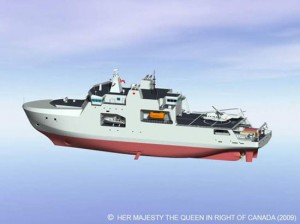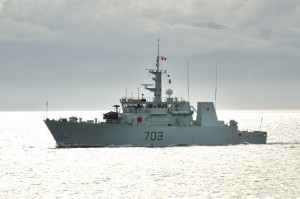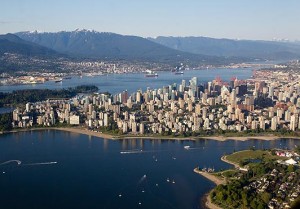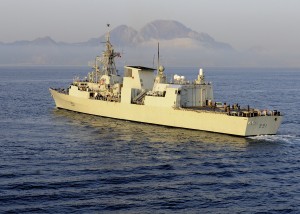
By Tomasz Trembowski
On August 16, 2011, the Canadian government announced the re-naming of Canada’s naval forces from “Maritime Command (MARCOM)” to its original designation, the “Royal Canadian Navy (RCN).” The last time Canada’s naval forces were known as the RCN was in 1968, when Lester B. Pearson amalgamated the three branches of the Canadian military under one command, named the “Canadian Forces.” Whatever name they operate under, Canada’s naval forces will continue to prove their importance in decades to come by playing a key role within NATO in increasingly critical waters.
Canada is proving its maritime mettle in a number of NATO operations around the world. Canadian vessels have played an active role in the NATO operation Active Endeavour. The operation was initiated on October 6, 2001, as a response to the September 11th attacks, which invoked NATO’s collective-security defence clause – Article 5. The aim of Active Endeavor is to keep the Mediterranean trade routes open and safe from pirates or terrorists, and to track and control vessels suspected of transporting weapons of mass destruction (WMDs).
Among the Canadian vessels that have participated in Canada’s portions of Active Endeavour, operations Sirius and Metric, are the Halifax-class frigates HMCS Charlottetown (FFH 339) and HMCS Vancouver (FFH 331). Most recently, Charlottetown returned to the Mediterranean in January 2012, continuing to patrol the area for suspect vessels until re-tasked to join Operation Artemis in April as part of Combined Task Force 150 (CTF-150) in the Arabian Sea. To date, Active Endeavour operations have hailed over 100,000 vessels and boarded some 155 suspect ships. Continued RCN participation in this operation not only gives Canada the capability to respond to crises in the immediate region but offers security to a region where a tremendous amount of world trade is conducted.
Another recent Canadian effort has been as part of Standing NATO Maritime Group One (SNMG1). SNMG1 is an integrated maritime force, consisting of four to six destroyers and frigates from different NATO Member and Partner countries, that plays an important part in maritime security. It normally operates in the eastern Atlantic Ocean during peace time. However since August 17, 2009, SNMG1 has been operating in and around the Gulf of Aden, a body of water that lies between the southern coast of Yemen and Somalia. The current operation, Ocean Shield, has made significant contributions to international efforts aimed at combating piracy off the Horn of Africa.
Within Ocean Shield Canadian vessels have played crucial roles. Among them, Charlottetown helped disrupt the movement of illicit cargo off the coast of Yemen. On May 5, 2012, for instance, Charlottetown successfully intercepted 600 pounds of hashish. Speaking at the changeover of Charlottetown with HMCS Regina (FFH 334) on August 19, Canadian Minister of National Defence, Peter Mackay stated, “Regina’s deployment continues our strong tradition of participation in overseas operations with our allies, while making meaningful contributions to international security and stability.” Ocean Shield is expected to end in 2014, but until then the Canadian Navy will no doubt continue to take an active role in the operation.
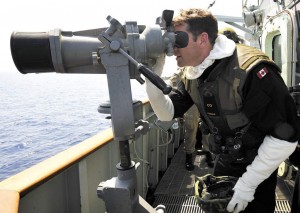
On March 23, 2011, NATO initiated Operation Unified Protector, under the command of Canadian Lt. General Charles Bouchard, to enforce UN resolutions 1970 and 1973 concerning Libya. The resolutions authorized NATO forces to maintain a no-fly zone and arms embargo against the Libyan government.
Both Vancouver and Charlottetown participated in the operation. On May 12, 2011, Charlottetown, along with French and British warships, engaged several Qadhafi regime small boats involved in an attack against the port of Misrata, and 18 days later came under fire from BM-21 rockets launched from shore. Meanwhile Vancouver worked alongside NATO allies to enforce the arms embargo placed against the Libyan government until its fall. As shown, Canada can and does play a leading role in NATO operations on the seas and oceans of the world.
The Canadian government was initially quite bellicose in its rhetoric regarding Arctic sovereignty, but more recently that stance has softened. The number of speeches mentioning new science and economic endeavours are outnumbering those proposing military bases, for example. However, in leaked US cables dating from 2010, Canadian Prime Minster Stephen Harper apparently cautioned NATO Secretary General Anders Fogh Rasmussen that NATO had no role in the Arctic and any such moves would only serve to increase tensions with Russia. According to the cable the PM commented that there is, “no likelihood of Arctic states going to war, but that some non-Arctic members favored a NATO role in the Arctic because it would afford them influence in an area where they don’t belong.”
In fact, there are plenty of reasons to get NATO involved. While a war among Arctic nations is indeed a far-fetched and unlikely event, there are other considerations to take into account. First, as the Northwest Passage becomes more easily navigable, experts predict the route may become the busiest waterway in the world. As the passage sees increased commercial traffic, a greater military presence will be required to inspect passing vessels for illicit or dangerous cargo, and to enforce possible environmental regulations.
Furthermore, Russia, the other major player with a massive interest in the Arctic, is already militarizing the region. Over the past few years, Russian air and submarine activity in the Arctic has reached levels not seen since the Cold War. It has even re-opened its old airbases on frozen archipelagos located above the Arctic Circle. Since Canada’s Arctic forces at current can’t hold a candle to Russia’s, a simple solution would see Canada include all NATO allies in current discussions taking place in the Arctic Council. This would be followed by working closely with all NATO allies to establish a new force primarily dedicated to the Arctic. This new force would naturally include the new Canadian vessels being built to operate specifically in the region. Such a move would no doubt give Canada a leading role in the matter considering the country’s proximity and forward position in the region. Why wait until Russia has moved deeper into the region and takes advantage of slow-moving talks in the Arctic Council?
Canada has already proven that it is a power on the oceans and seas of the world by aiding in counter-terrorism operations, anti-piracy operations, and naval warfare operations. It can be proud of its RCN and the contributions and leadership it provides to both past and present NATO operations. Now, however, is the time to codify a new role for the RCN for the new century – the Arctic. This of course, is solely in the hands of the Canadian government. All it has to do is reach out and include its NATO allies.
This article appeared in its original form and was cross-posted by permission from The Atlantic Council of Canada.


